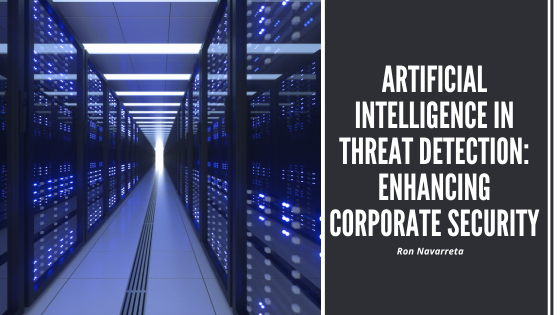In the ever-evolving landscape of cybersecurity, the role of artificial intelligence (AI) has become increasingly pivotal, especially in the realm of threat detection. As businesses navigate an intricate web of digital vulnerabilities, AI emerges as a powerful ally in fortifying corporate security measures.
The Growing Complexity of Cyber Threats:
The digital era has ushered in unprecedented opportunities for businesses but has also given rise to sophisticated cyber threats. Traditional security measures often struggle to keep pace with the ever-evolving tactics of cybercriminals. In this dynamic landscape, AI emerges as a proactive and adaptive solution to counter the complexity of modern cyber threats.
Proactive Threat Detection with Machine Learning:
AI-powered threat detection relies heavily on machine learning algorithms to analyze vast amounts of data and identify patterns indicative of potential security risks. Unlike rule-based systems, machine learning adapts and evolves, continuously refining its understanding of normal and anomalous activities. This proactive approach enables AI to detect emerging threats in real time, often before they escalate into full-blown security incidents.
Behavioral Analytics and Anomaly Detection:
AI excels in behavioral analytics, allowing it to discern normal patterns of user behavior within a network. By establishing a baseline of typical activities, AI-driven systems can swiftly identify anomalies or deviations that may signal a security threat. Whether it’s an unauthorized access attempt or unusual data transfer patterns, AI’s ability to detect subtle deviations enhances the capacity for early threat detection.
Enhanced Speed and Efficiency:
Manual threat detection can be time-consuming and prone to human error. AI, on the other hand, processes data at speeds unimaginable for human analysts. The rapid analysis of vast datasets allows AI to identify and respond to potential threats with unparalleled efficiency. This speed is particularly crucial in mitigating cyber threats that can unfold in a matter of minutes or seconds.
Scalability and Adaptability:
Corporate networks are not static entities; they evolve, expand, and encounter new challenges regularly. AI-driven threat detection systems are inherently scalable, capable of handling increased data volumes and adapting to changes in network architecture. This scalability ensures that as businesses grow, their cybersecurity infrastructure can seamlessly expand to match the evolving threat landscape.
Predictive Analysis and Trend Identification:
AI goes beyond immediate threat detection; it leverages historical data and predictive analysis to identify potential future threats. By recognizing patterns and trends, AI enables businesses to adopt a proactive security stance, anticipating and mitigating potential risks before they materialize. This forward-looking approach enhances the overall resilience of corporate cybersecurity.
Reducing False Positives:
One of the challenges in traditional threat detection is the occurrence of false positives, where security systems mistakenly flag legitimate activities as potential threats. AI algorithms, with their ability to learn and adapt, continuously refine their understanding of what constitutes normal behavior within a network. This learning process reduces false positives, allowing security teams to focus on genuine threats and minimizing the chances of overlooking critical issues.
Integration with Security Operations:
AI in threat detection seamlessly integrates with security operations, streamlining incident response and threat mitigation. Automated responses triggered by AI algorithms can isolate compromised systems, block suspicious activities, and even initiate remediation measures. This integration accelerates the incident response time, minimizing the impact of security breaches on corporate assets.
The Human Factor:
While AI plays a crucial role in threat detection, it does not replace the human element in cybersecurity. Human analysts bring contextual understanding, intuition, and the ability to comprehend complex socio-technical aspects of cyber threats. The synergy between AI and human expertise creates a formidable defense against evolving cybersecurity challenges.
The Future of AI in Corporate Security:
As AI continues to evolve, its role in corporate security is poised to expand further. The integration of AI with other advanced technologies, such as threat intelligence feeds, blockchain, and quantum computing, holds the promise of creating even more robust defense mechanisms against sophisticated cyber threats.
Moreover, the development of explainable AI (XAI) is addressing the need for transparency in AI-driven decision-making. This is especially crucial in cybersecurity, where understanding the reasoning behind AI-driven threat assessments is essential for building trust in these systems.
In the digital era, where cyber threats are dynamic and ever-evolving, the incorporation of artificial intelligence in threat detection is no longer a luxury but a necessity. The adaptive, proactive, and scalable nature of AI aligns seamlessly with the demands of modern cybersecurity, offering businesses a formidable defense against a myriad of digital threats.
As the synergy between AI and human expertise continues to strengthen, the future of corporate security looks promising. The relentless pursuit of innovation in AI-driven threat detection is not just a response to the challenges of today but a proactive investment in securing the digital landscapes of tomorrow. In the relentless battle for cybersecurity, AI stands as a sentinel, constantly evolving to guard the gates against an ever-changing array of digital adversaries.

